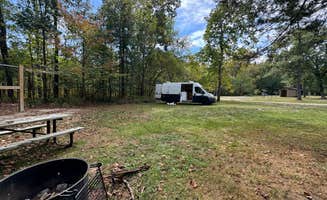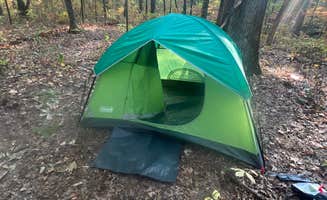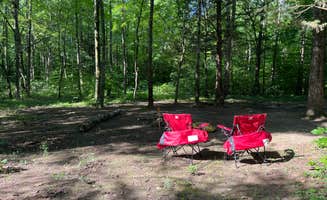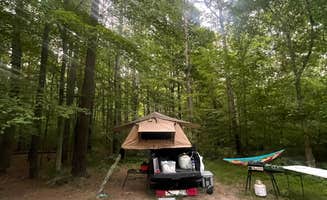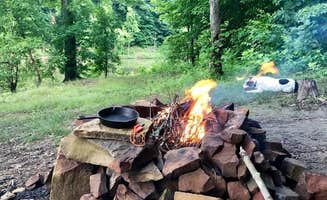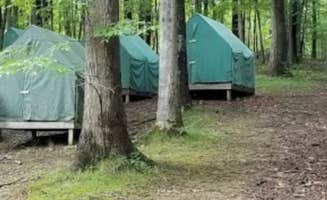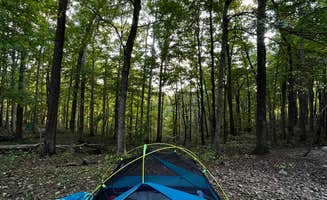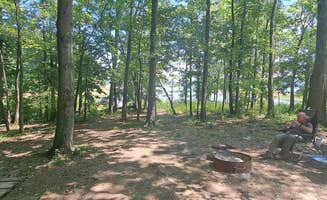Dispersed camping opportunities near Norman, Indiana range from backwoods locations with no amenities to sites with basic facilities. The Charles C. Deam Wilderness contains over 12,000 acres of forest with multiple camping areas available by hiking in or accessing from Tower Ridge Road. Elevations in the region vary from 560 feet at lake level to over 800 feet on surrounding ridges, creating diverse camping environments from lakefront locations to wooded hilltops.
What to do
Boat rental options: During summer months at Paynetown Campground, visitors can rent pontoons, canoes and kayaks. "They offer pontoons, canoes and kayaks for rent. We'll definitely be back!" notes Jennifer H. who appreciated the convenience of combining boating and camping.
Cave exploration: At Spring Mill State Park Campground, unique boat tours through underground caves provide unusual experiences. "There is a cave tour also on offer in which you ride thru the cave system in a boat. Yes there are even lifevests for customer to wear!" writes Rachel W.
Mountain biking trails: The mountain biking system at Buffalo Ridge Campground includes purpose-built trails for various skill levels. As one visitor notes, "The mountain biking is excellent, with purpose built trails for beginner to expert (flow, berms, rollers, jumps...)."
Hiking to the lake: The Peninsula Trail in Charles C. Deam Wilderness offers backcountry hiking with lakeside campsites. "We found so many geodes along the way. Lake Monroe is one of my favorite places to be, the sunsets are magical," shares Caitlin W., highlighting the geological features.
What campers like
Lakefront camping sites: Electric sites along the water at Starve Hollow State Recreation Area allow campers to fish from their campsite. Martin M. reports, "We stayed in site 21 which was right on the lake. All the lake front spots seem to have a good amount lakefront footage. We probably had at least 40 feet."
Secluded free camping: Berry Ridge Road dispersed camping offers isolation without cost. "Beautiful secluded site that is pretty far off of the road, but not too far. There was no traffic or other people in site," explains Amber R., who appreciated the privacy.
Primitive camping with water views: Peninsula Trail provides free wilderness campsites with lake access. "On the peninsula trail, there are multiple campsites with fire rings but you may also camp anywhere if you are at least 100 ft from the water. Campsite #18 has a great view and is large enough for at least 4 tents if you have a big group," shares Aspen B.
Shaded sites: Taylor Ridge Campground offers wooded camping areas preferred by tent campers. "We stayed in Taylor which was dubbed 'wooded' and the one I would most suggest. The others were pretty cleared out and too close together," reports Caitlin W.
What you should know
Weather considerations: Rain can significantly impact access and comfort at forest campgrounds. "If you're a solar person, this is your spot! It's a giant open field with vault toilets. If you're looking for shade or here in the summer months, you may try elsewhere as there is not much shade to be had," explains Juniper L. about Blackwell Campground.
Site terrain: Many campgrounds in the region have uneven terrain requiring careful setup. "The site we stayed in was lovely. It was backed up to the edge of the woods which made for a lovely view. I would say pay particular attention to the size of the site you're booking as some were pretty small. Also, some sites were fairly sloped as well," warns Amanda D.
Wildlife awareness: The forested areas contain various wildlife including snakes. "Springs available in the valleys but watch for timber rattlesnakes," cautions Elliot F. who camped with his family in the backcountry.
Water access challenges: Getting to lake access points can require significant hiking. "Long walk to the water so make sure you bring plenty of drinking water," advises Elliot F. about backcountry camping.
Tips for camping with families
Activity centers: Hardin Ridge offers structured activities for children. "There are at least one pair, some two, camphost pairs in each loop. While the campground is not a rest home by any means, it is not a party place such as Allens Creek or Paynetown campgrounds that share the same lake," explains Deb T.
Multiple playgrounds: Several campgrounds feature playground equipment for children. "The bathhouse was clean (even though it rained most of the weekend). The beach area was huge and there were a lot of playgrounds," notes Martin M. about Starve Hollow.
Educational opportunities: Ranger-led programs provide learning experiences. "They had a Smokey the Bear program for the kids and some really fun activities at the nature center while we were there," shares Jessie W. about her family's experience at Spring Mill State Park.
Beach access: Swimming areas with gradual entry points work well for families with small children. "This campground is on the south side of Monroe lake and has beach access. I tent camped solo and everything went great!" reports Christine C. who visited Hardin Ridge.
Tips from RVers
Site selection concerns: Check campground roads and specific site dimensions before booking. "The roads to get to the sites are tight (especially as it's filled up heading into the weekend)," notes Jennifer H. about navigating Paynetown State Recreation Area.
Road conditions: Access to many campgrounds requires navigating gravel roads. "Easy to find but slow going w rig on winding narrow roads," cautions Cj H. about reaching Blackwell Campground.
Leveling requirements: Many sites throughout the region require leveling equipment. "I hate it when the camper wheels are off the ground. The sites are good sized for camping alone or with a group," mentions Jennifer H. about her experience at Paynetown.
Low clearance warnings: Some campground entrances have specific restrictions. "The north entrance is through a covered bridge with a 9 foot clearance and 3 ton limit! Otherwise, use the easily accessible west entrance, just a few miles 'around the corner,'" advises a visitor to Buffalo Ridge Campground.


